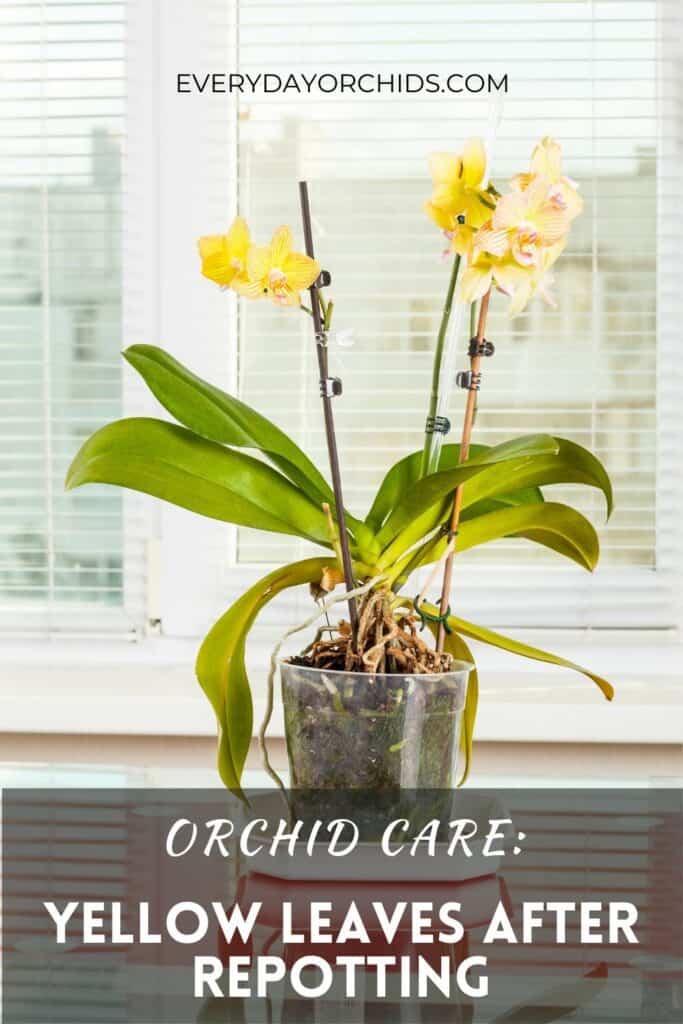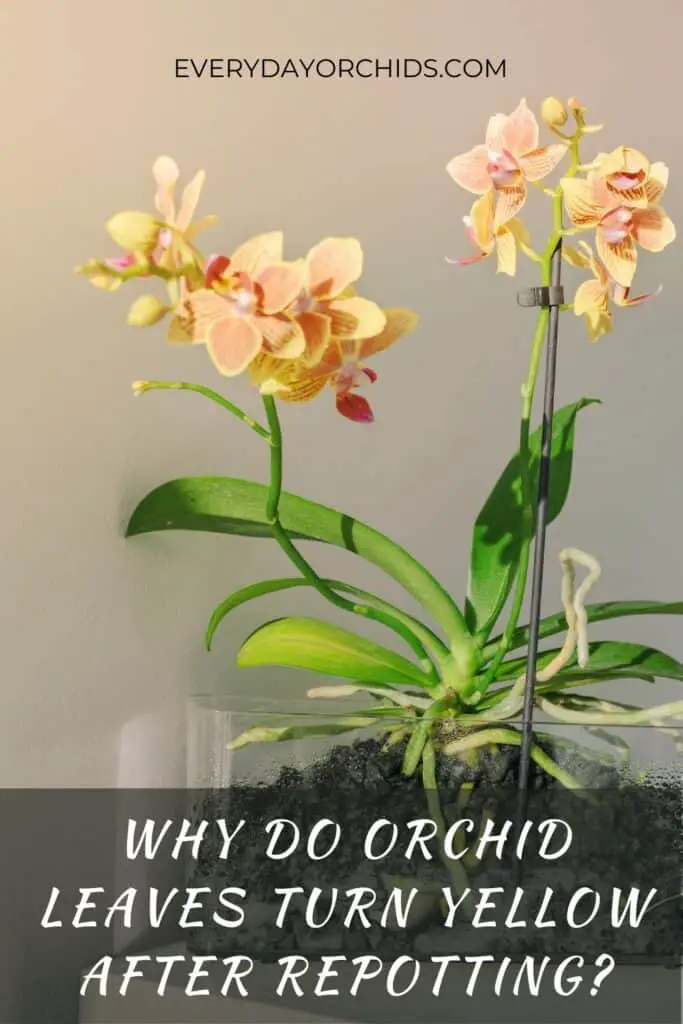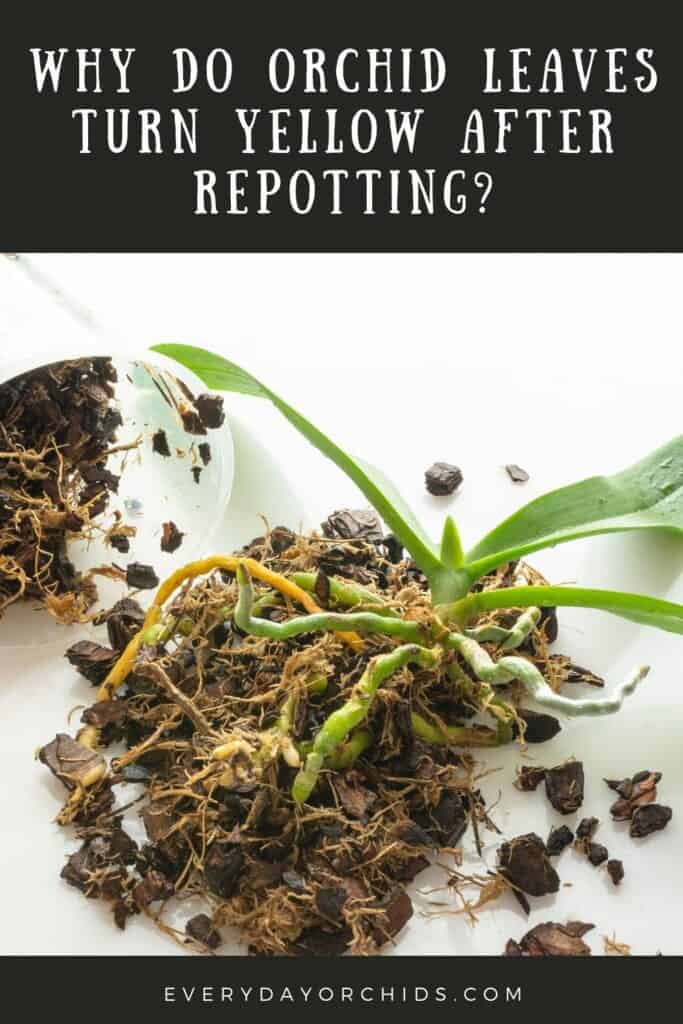Have you just repotted your orchid, done everything right, and yet the orchid leaves still turned yellow after repotting? This is actually a common occurrence and I don’t want you to worry. Understanding why this happens will help you anticipate the changes in your orchid and better care for it during and after repotting.
Orchid leaves can turn yellow after repotting due to several reasons. This includes transplant shock, or trauma, low humidity, a change in potting media, and/or a change in the type of potting media used.
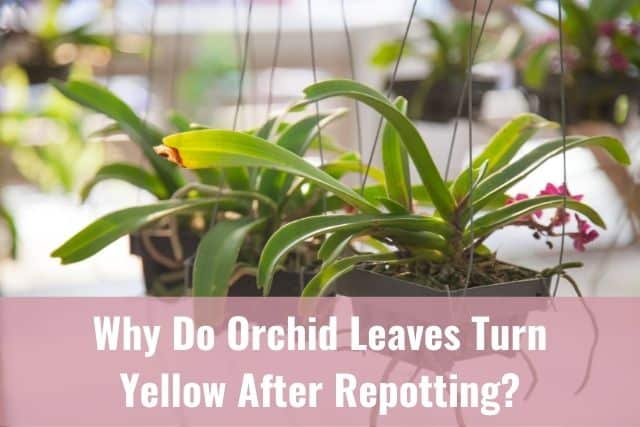
In my previous article, I talked about why orchid leaves turn yellow. However, I wanted to separately address why you may orchid leaves may turn yellow after repotting.
Let’s go into more detail about each of the reasons why orchid leaves turn yellow after repotting. I’ll also answer the question about whether these yellow orchid leaves can turn green again. Keep reading to learn more.
Please note that these links are affiliate links and as an Amazon Associate, I earn from qualifying purchases. Purchases made through affiliate links in this post may generate commissions at no additional cost to you. Use this link for a discounted Amazon Prime trial. Thank you for your support!
Table of Contents
Reasons Why Orchid Leaves Turn Yellow After Repotting
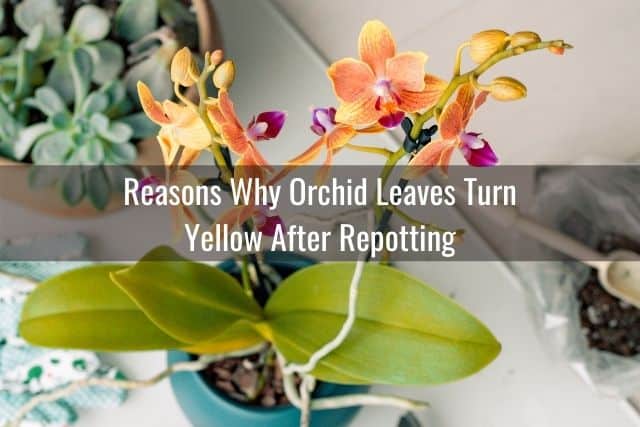
Sometimes you will notice that after you repot your orchid, the leaves may turn limp or become slightly yellow. An orchid may even lose a leaf or two after repotting. Don’t worry, this is totally normal.
Usually the bottom leaves will be the first ones to turn yellow and fall off, usually due to natural causes such as old age. However, this may not always be the case after repotting. Leaves can indiscriminately turn yellow and drop off after repotting, regardless of where they are on the orchid. This happens for a few reasons. One of the biggest reasons is stress, or transplant shock. This can also happen due to changes in humidity and potting media.
Transplant Shock
First of all, know that the simple act of repotting was likely a huge shock to the orchid’s system.
If your orchid leaves turn yellow soon after it was just repotted, transplant shock is the most likely reason for this. Repotting can be very stressful for plants. Yellowing leaves is one way that stress is manifested.
In addition, you likely pruned away numerous dead or rotted roots during the repotting process, which adds to the stress and trauma. Your orchid will need some time to adjust to it’s new surroundings and recover. In this situation, yellow orchid leaves are usually a sign of transplant shock.
Adjusting To New Potting Media
When you repot an orchid, you generally use fresh, new orchid potting media. This may sound obvious, but the new potting media is going to be drier than the previous potting media. The old potting media was probably starting to decompose. This naturally made it more water-retentive with smaller pieces of bark. Not so with the new potting media.
After repotting your orchid, you will likely find that it needs more frequent watering than before. This is because the new potting media will dry out more quickly than the older potting media.
If you see yellowing orchid leaves after repotting, this may be a sign that your orchid needs more water. In addition, leaves that are starting to wilt are a clear sign that the orchid isn’t getting enough water.
As always, check the potting media before you water. Just as your orchid is adjusting to the new environment, you will also need to adjust your care to meet the needs of the newly repotted orchid.
Low Humidity
In addition, low humidity levels can also cause the orchid leaves to turn yellow and fall off after repotting. Again, this is because the new potting media is drier, airier and retains less moisture.
In other words, after repotting, the new potting media isn’t as water-retentive as the old one. As a result, there is generally less humidity and moisture around the orchid roots. This can cause them to dry out and as a result, you will see wilting or yellowing orchid leaves.
To address this, first find out what your orchid’s specific care requirements are. Use a hygrometer to measure the current humidity levels in your orchid’s growing area. Then, supplement humidity levels with a humidity tray or a humidifier.
Proper humidification is so important for an orchid’s health and growth. Managing humidity around your orchid will go a long way in keeping your it happy and healthy.
Using Different Potting Media
If you have an orchid that was grown in sphagnum moss and you repot it into a bark-based potting media, there is a high chance you’ll see yellow orchid leaves soon after repotting.
This is because bark-based potting media is less water-retentive than sphagnum moss. As a result, there will be less humidity around the roots.
These factors, along with the factor of transplant shock, are what causes orchid leaves to turn yellow soon after you repot into a different potting medium.
You can read more about the differences between bark vs moss here.
In general, it is recommended to stick with the same type of potting medium. For example, if an orchid was potted in moss, then use new sphagnum moss for repotting. If an orchid was potted in bark, then use new bark-based potting media to repot the orchid.
Repotting into the same type of potting media will help minimize the stress on the orchid.
However, there are certain situations where you may want to switch the type of potting media used. I talked about this briefly elsewhere on Everyday Orchids when I went over how to water orchids potted in moss.
While it is generally recommended to use the same type of potting media, changing the type of potting media can definitely be done. I’ve repotted orchids from moss to bark many times and haven’t lost an orchid yet. However, be warned that you will likely see yellow orchid leaves and/or some roots dry out as the orchid adjusts to the new environment.
What To Do If Orchid Leaves Turn Yellow After Repotting
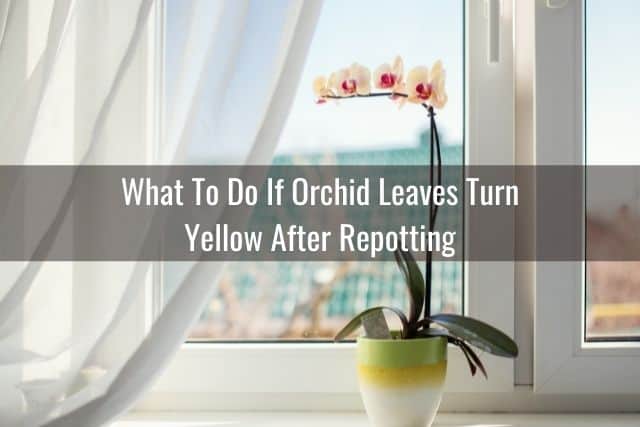
To help the orchid through this transition and recover from transplant shock, be sure to give your orchid lots of attention and TLC (tender loving care) during this time.
Here are some tips:
- Pay closer attention to your orchid’s watering needs. Always check the potting media before you water. You might find that your orchid needs more frequent watering due to the new potting media.
- Maintain ideal humidity levels according to your orchid’s care needs. You can monitor humidity levels with a hygrometer. Supplement with a humidifier or a humidity tray as needed. Otherwise, you will likely see some roots start to dry out.
- Continue to give your orchid lots of bright, indirect light and good air circulation around the pots. If your home doesn’t get enough natural light, you may need to supplement with artificial lighting.
- Continue to feed your orchid regularly with a balanced orchid-specific fertilizer.
If the orchid has difficulty adjusting to the new potting media and environment, you may see leaves continue to yellow and wilt and orchid roots start to dry out. Some of those yellow orchid leaves, usually the older leaves, may even fall off.
Don’t worry, just give the orchid some time to adjust. It may take a few months, but continue to water and fertilize your orchid regularly and give it lots of bright, indirect sunlight. Your orchid will recover and in time, you should start to see new growth emerge.
Will Yellow Orchid Leaves Turn Green Again?
Yes, once an orchid recovers, sometimes a slightly yellow orchid leaf can turn green again. However, this can take weeks to happen. Sometimes the yellow orchid leaf will remain yellow and eventually fall off.
Whether or not the yellow leaf turns green again really depends on several things: the overall health of the orchid, the conditions surrounding the repotting process, and the amount of transplant shock endured.
If your orchid ends up losing one or two yellow leaves after repotting, I wouldn’t worry about it too much. If your orchid has recovered and adjusted well after repotting, you will see new growth, such as new root buds and new leaves, start to emerge in the months following repotting.
If you are curious to learn more about how fast orchids grow, read this guide on season-by-season orchid growth.
Final Thoughts
To sum it up, orchid leaves turning yellow after repotting is actually fairly common. It happens as the orchid tries to adjust to the new potting media and environment and deals with transplant shock.
Don’t worry if you see a few orchid leaves turn yellow or even fall off. This can happen and is normal. As long as you are providing great care to your orchid, it will recover. Leaves or roots that were lost during or after repotting will be replaced with new leaves and roots in the following months. Just give it time.
Hope this has helped you! As always, happy orchid growing.
If you enjoyed this article, please pin it and share!
